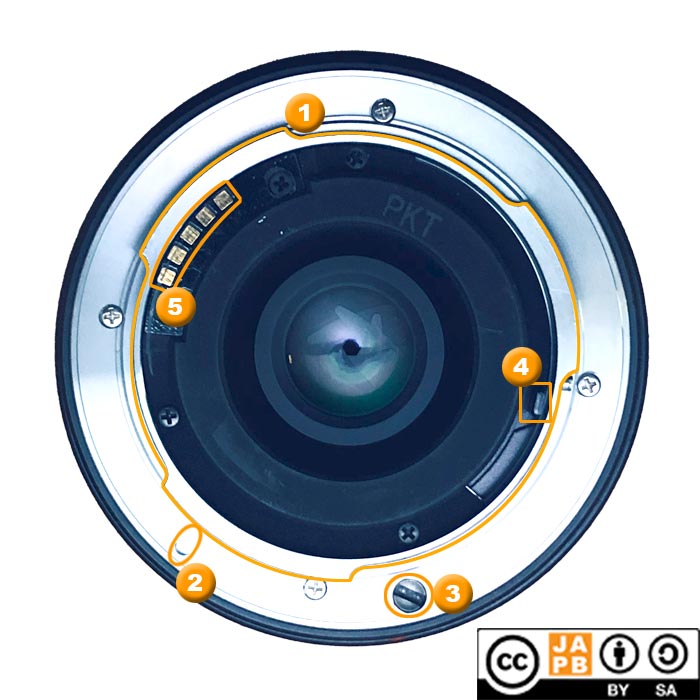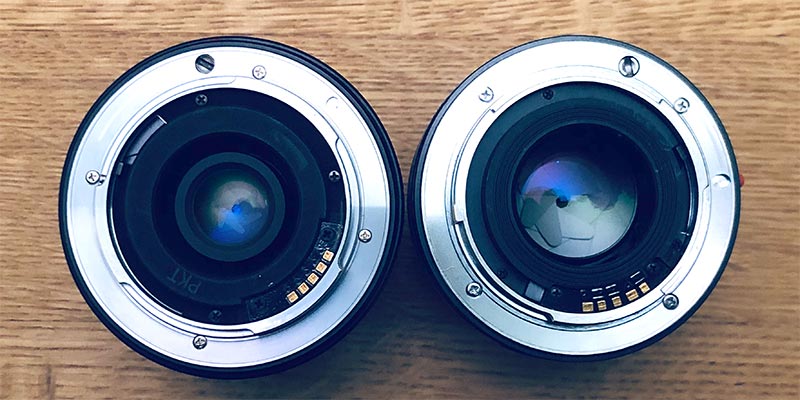Please be advised: The Yashica AF mount is sometimes also referred to as the Yashica 230 mount, even as the Yashica/Kyocera mount, which is – as will be detailed below – something of a misnomer. This article will simply refer to it as the Yashica AF mount.
Yashica AF mount specifications and identification
Mount type: Bayonet (male-type)
Flange focal distance: 45,8 mm (measured)
Film format: 36mm x 24mm (‘Full frame’)
Mount communication (mechanical): aperture stop-down (camera-to-lens); slot-drive AF (camera-to-lens)
Mount communication (electronic): 5/10 electronic contacts (spring-loaded at the camera-end). Early (pre-power zoom) lenses with 5 contacts; power zoom lenses with 10 contacts. Entire extent of communication (designed/implemented) unknown to JAPB

Key characteristics of the mount of Yashica AF lenses:
[1] Three-pronged male bayonet. All edges tapered.
[2] Locking groove at roughly 07:30 o’clock.
[3] Slot-drive screw at roughly 05:30 position
[4] Stop-down lever
[5] Electronic contacts between 10:00 and 12:00 (5 on regular AF lenses; 10 on power zoom lenses).
[not visible] Yashica AF lenses lack an aperture ring.
A short history of the Yashica AF mount:
While several AF-contraptions had been attempted earlier (including Olympus OM-30, Pentax ME-F, Nikon F3AF, Canon T80 ), the real start of autofocus interchangeable lens cameras happened in 1985 in the form of the Minolta 7000 AF (Maxxum 7000 in North America; Alpha 7000 in Japan) and its attendant new lens mount. (For a rundown of the history of AF on SLR’s as well as various approaches to implementing AF, see the JAPB article on autofocus).
While all Japanese major camera companies had development programs aiming at developing autofocus system cameras, the launch of the Minolta A system put the cat among the pigeons. As a result, the entire competition felt forced to launch their systems sooner rather than later.
Unsurprisingly, Yashica did not want to be left behind, but Yashica was also in a somewhat unique pickle. In 1973 Yashica had collaborated with Zeiss of Germany to launch the Contax/Yashica system – a system that had given Yashica a technologically successful foothold, while never being quite the financial success Yashica had hoped for. Resultingly, Yashica had been acquired by Kyocera in 1983, and the collaboration with Zeiss – critical for Yashica having access to Zeiss designs and the Contax-name – had continued.
Warning! The following is based on my educated guesses, based on relatively incidental accounts:
Yashica/Kyocera had approached Zeiss regarding producing an autofocus system, and it had even led to a public, functional prototype in 1982 (three years ahead of Minolta), but Zeiss was far less than enthusiastic. Given that the almost entire photographic industry was convinced that pros and prosumers would never fall for autofocus, Zeiss’ lack of interest is understandable. Hence, Yashica decided to develop their AF SLR system on their own, and independently of the existing Contax/Yashica system.
Yashica settled on an AF mount construction that is not unlike that of the pioneer Minolta, combining a mechanical aperture stop-down lever, a slot-drive screw for driving the lens’ AF gearing, as well as a number of electronic contacts for lens-camera communication. In fact, the two mounts are strikingly similar, but nevertheless entirely incompatible.

Both mounts sport: Three pronged (male) bayonet, locking groove on flange, mechanical aperture lever, 5 electronic contacts, slot-drive screw.
Even so, the mounts are not compatible.
But history would have to deem Yashica’s attempt at entering the AF SLR market as a failure: While Yashica introduced four models of AF SLRs (230 AF, 200 AF, 270 AF and 300 AF) over 6 years (1987–1993) as well as roughly 20 lenses, Yashica/Kyocera soon discontinued the production of Yashica-branded AF cameras1.
Why did the Yashica AF system fail? There are a lot of opinions. Some are of the opinion that Yashica simply did not have the industrial and marketing power necessary to launch a new system (indeed, an entirely new SLR platform), especially as Yashica was also forced to keep supporting the Contax/Yashica platform. Some point out that the Yashica system simply did not have the breadth of Canon or Minolta, nor the usable back catalog of Nikon or Pentax. People with first-hand experience of the Yashica AF system typically complained that Yashica had gone a step too far into automation (even before power zooms), making any semblance of manual control too difficult. Some also considered that while the Yashica AF bodies were highly sophisticated, their ergonomics were hideous (exactly 0 dials, just buttons and sliders). In any case, these rationalisations very much remind me of another AF system that failed even faster.
Adapting Yashica AF lenses
Note please: JAPB has insufficient data to be able to discuss the adaptability of the Yashica AF power zoom lenses, but there is a distinct possibility that the adaptability of these lenses will be significantly curtailed. The guide below therefore applies only to non-power zoom Yashica AF lenses:
Firstly, If you have a film-era Yashica AF camera you can still use your Yashica AF lenses.
If you’re using a mirrorless camera, it is possible to use Yashica AF with a suitable adapter. However, because Yashica AF lenses lack an aperture ring, you will need an adapter that is able to change the lens’ aperture by direct manipulation of the Yashica AF lens’ aperture stop-down lever.
Furthermore, Yashica AF lenses can be adapted (albeit without autofocus or stop-down automation) to most other dSLR mounts (including Canon EF, Nikon F, and Pentax K) using an adapter that combines the ability to manipulate the lens’ aperture with optics to allow for infinity focus.
Footnotes
- Yashica did, after a fashion, re-enter the manufacture of AF SLRs at a later date in the form of the Contax N series of cameras and lenses. ↩︎